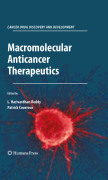
In spite of the development of various anticancer drugs, the therapy of cancer has remained challenging for decades. The current therapy of cancer is overwhelmed because of the inability to deliver therapeutics to all regions of a tumor in effective therapeutic concentrations, intrinsic or acquired resistance to the treatment with currently available agents via genetic and epigenetic mechanisms, and toxicity. As a result, cancer therapy using conventional therapeutics and different types of treatment regimens using this therapeutics has not led to a convincing survival benefit of the patients. In this context, Macromolecular therapeutics offer several advantages over conventional low molecular therapeutics by various ways such as, enable the use of larger doses of these agents by limiting the toxicity, by enhanced permeability and retention intotumors, by tumor targeting using tumor-specific antibodies, by specific inhibition of oncogenes using anticancer oligonucleotides etc. Cancer treatment using this macromolecular therapeutics has considerably improved the survival benefit for patients. As a result, various macromolecular therapeutics are already commercialized or are under clinical development. Although we are far from areal magic bullet today, looking at the pace of research and current success in this field of macromolecular therapeutics, it appears that we are approaching a magic bullet for the efficient treatment of cancer. Thus, we believe thatthe subject of this book is very timely, and that the book will fill an unmetneed in the market. This book is unique and assembles various types and aspects of macromolecular anticancer therapeutics for cancer therapy in one shell and conveys the importance of this interdisciplinary field to the broad audience. Thus, in a nutshell, this book details the basics of cancer, and various therapeutic strategies such as those based on macromolecular therapeutics hence can become an important reference for practitioners, oncologists, medical pharmacologists, medicinal chemists, biomedical scientists, experimental pharmacologists, pharmaceutical technologists, and particularly it can essentially become a handbook of macromolecular therapeutics for cancer therapy for graduates,post-graduates and Ph.D. students in these fields. INDICE: Classification of anticancer drugs based on therapeutic targets.- Signal transduction pathways as therapeutic targets in cancer therapy.- HPMA-anticancer drug conjugates.- Poly(L-glutamic acid)-anticancer drug conjugates.-Polysaccharide-based anticancer prodrugs.- PEG-anticancer drugs.- Poly(ethylene glycol)-protein, peptide and enzyme conjugates.- Lipid-based anticancer prodrugs.- Antibody-Cytotoxic Compound Conjugates for Oncology.- Immunoconjugate anticancer therapeutics.- Antibody directed enzyme prodrug therapy (ADEPT) forcancer.- EGFR-directed monoclonal antibodies.- The biology of the HER family and Her2/neu directed-antibody therapy.- Anti-Vascular Endothelial Growth Factor monoclonal antibodies.- Monoclonal Antibody Therapy for Hematologic Malignancies.- Anticancer Oligonucleotides.- New molecular therapeutic interventions:the case of breast cancers.
- ISBN: 978-1-4419-0506-2
- Editorial: Springer
- Encuadernacion: Cartoné
- Páginas: 500
- Fecha Publicación: 01/11/2009
- Nº Volúmenes: 1
- Idioma: Inglés
